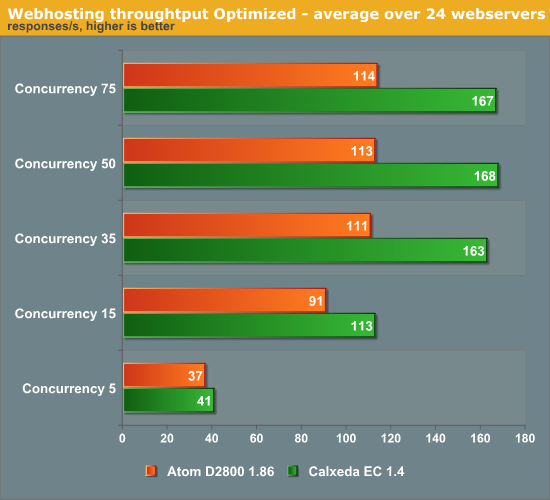Server Update April 2013: Positioning the HP Moonshot 1500
by Johan De Gelas on April 11, 2013 8:11 AM EST- Posted in
- Enterprise CPUs
- Arm
- Xeon
- Enterprise
- Calxeda
- S1200
Estimating S1260 Server Performance
As the Atom S1260 is very similar to the Atom N2800, we went one step further. We tested the 32 nm Atom in a real workload, the same workload that we used in our review of the Calxeda based Boston Viridis server.

It is simple: even at 2GHz, the Atom S1260 is no match for Calxeda's EnergyCore at 1.4GHz. The EnergyCore is the better server chip thanks to out of order execution, a 4 times larger L2-cache (4 MB) and the fact that it can offer 4 real cores. Even if we assume that the 2GHz Atom S1260 performs 8% better thanks to its higher clockspeed, it is no match for Calxeda's EnergyCore.
So let us summarize. The current A9 based Calxeda EC 1.4GHz is about 40% faster and consumes half the power of the Atom S1260. Therefore it is not unreasonable to assume that the performance per Watt ratio of the Calxeda SoC will be up to 3 times better.
There are more indications that our assumptions are not far off. We quote the white paper at HP's site (page 5):
"A completely populated system will be in the ~850W ballpark. That system powers 180 x 2.0GHz threads, with 2GB of RAM for each thread, at under 5W per thread."
That means that each cartridge needs about 19 W. Let us assume that 4 W is taken by the disk. That is generous as in most webserving workloads, the disk will be hardly active. That means that one server node needs about 15 W. Compare this with a measured 8.3W per Calxeda server node and you'll understand that there is little doubt in our minds that the S1260 is nowhere near the performance/watt of the ARM alternative.










26 Comments
View All Comments
pixelstuff - Thursday, April 11, 2013 - link
The acronyms were quite prolific in this article.WeaselITB - Thursday, April 11, 2013 - link
IDK, TLAs R AOK w/me.mayankleoboy1 - Thursday, April 11, 2013 - link
AFAIk, LZMA uses only two threads...LZMA2 can use as many as required. Can you do another benchmark, this time with LZMA2 algo, and set the number of threads to something big.
mayankleoboy1 - Thursday, April 11, 2013 - link
Nevermind, i thought you were testing on the complete thing, not only one node.JohanAnandtech - Thursday, April 11, 2013 - link
The benchmark actually spawns 4 threads if you instruct it to do that.mayankleoboy1 - Thursday, April 11, 2013 - link
Those 4 threads would be 4 processes, right ? Or a single process with 4 threads ?Kevin G - Thursday, April 11, 2013 - link
Any news of Intel's ISCCC coming to market? Even if performance is the same, it further integrates the various nodes further for greater density and the possibility of lower performance.Gigaplex - Thursday, April 11, 2013 - link
I wonder how AMDs Bobcat would compare in this scenario.Spunjji - Friday, April 12, 2013 - link
Probably average, not great at anything though as its PPW is probably lower than ARM in this scenario. That's mostly due to outdated process tech, though, so Jaguar might well be a nice competitor; even more so if people can figure out novel ways to use the GPU.fteoath64 - Wednesday, April 17, 2013 - link
The Atom is between a rock-and-a-hard-place. It is only good for consumer NAS devices and nothing really else. The Bobcat cores are worse in power consumption while 25% SLOWER than the Atom , so it is pretty useless, although its gpu is rather respectable at 80 cores. The low power Xeon Haswell is rather nice and should be developed (or sliced and diced) into the "New" Atom2 architecture, saving Intel the dearth of the Atom brand that has long since been dead and beaten over and over. There is no shame for Intel on this "dead horse". they kept beating it for all to see!.